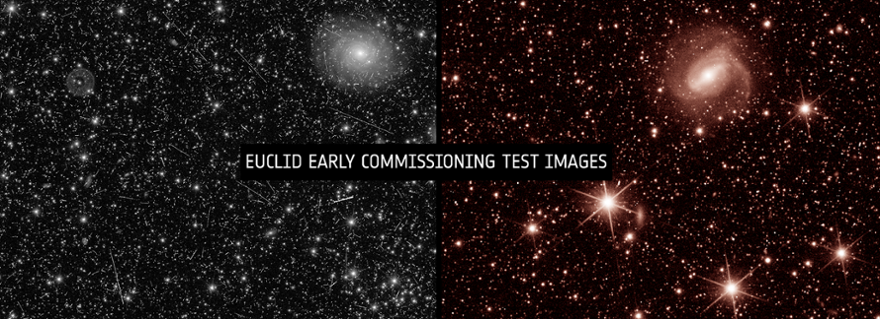
Space telescope Euclid makes first test images - astronomers are full of anticipation
The two instruments of ESA's space telescope Euclid have taken their first test images. The first images indicate that the space telescope will achieve the scientific goals for which it was designed - and possibly much more. Euclid will create a 3D map of a third of the sky, allowing scientists to study the last 10 billion years of the Universe's evolution and investigate the nature of dark matter and dark energy. Members of the Euclid Consortium, including astronomers Henk Hoekstra and Koen Kuijken of Leiden University, are elated.
Although there are still months to go before Euclid will unfold its new view of the cosmos, reaching this milestone means that the scientists and engineers behind the mission can be confident that the telescope and instruments are working well. ‘After more than 11 years of designing and developing Euclid, it is exciting and emotional to see these first images,’ said Euclid project manager Giuseppe Racca (ESA). ‘Especially when you consider that we are seeing just a few galaxies here, produced with minimal system tuning. The fully calibrated telescope will eventually observe billions of galaxies and produce the largest 3D map of the sky ever.’
The Universe in visible light
Euclid's VISible instrument (VIS) will take incredibly sharp images of billions of galaxies to measure their shape. With the VIS images, scientists will get their first glimpse; while a few galaxies are very easy to see, many more are vague patches hidden among the stars, waiting to be unmasked by Euclid in the future. Although the image is very detailed, the sky surface covers only a quarter of the width and height of the full moon. That is one millionth of the total area of the sky that Euclid will map over the next six years.
The Euclid team was startled when the instrument was first turned on: an unexpected light pattern contaminated the images. Follow-up investigation revealed that some sunlight was sneaking into the telescope, probably through a small opening. After Euclid was rotated, it became clear that this light was only captured at specific orientations. So VIS can fulfil its mission by avoiding certain angles.

The Universe in infrared light
Euclid's Near-Infrared Spectrometer and Photometer (NISP) instrument has a dual role: to record galaxies in infrared light and to measure the amount of light that galaxies emit at different wavelengths. The latter can be used to determine how far away each galaxy is.
Combining information about distance with information about the shape of galaxies measured by VIS will map how galaxies are distributed across the universe and how this distribution changes over time. Ultimately, this 3D map will provide information about the mysterious dark matter (which exerts its gravitational pull on ordinary matter) and dark energy (which likely drives the current acceleration of the expansion of the Universe).

About Euclid
Euclid is an ESA mission with major contributions from industry and the Euclid Consortium, an organisation that brings together more than 2,500 scientists from 300 institutes in 17 different countries in Europe, the US, Canada and Japan. The consortium is responsible for designing and building the NISP and VIS instruments, and for collecting all additional data on the ground. But also for developing the research strategy and data processing pipeline to produce all the calibrated images and catalogues, and for the scientific exploitation of the data Euclid will send to Earth. Astronomers from the Leiden Observatory and the University of Groningen are members of the Euclid Consortium. The Science Data Center for Euclid in the Netherlands, which will help process the vast amount of data, is housed at the University of Groningen.
Excited
‘They are beautiful pictures - and this is just the beginning,’ said Henk Hoekstra (Leiden University). ‘We are definitely delighted! Especially after the initial shock when VIS measured a higher background than expected. Fortunately, a solution was found quickly. For weak lensing measurements the sharp images are even more important than the low background, so it's great to see that we achieve the required sharpness over the whole field.’ Koen Kuijken (Leiden University) continues: ‘Now we have to wait for the survey to begin. But based on these first images we expect to discover a lot about the distribution of dark matter in the Universe, where the deep infrared images will also help to determine distances to galaxies.’
Test shots
The photos published today are early test shots, taken to check the instruments and determine how to further tune the telescope. Because they are largely unedited, some unwanted artefacts remain - for example, cosmic rays shooting through the image. The Euclid Consortium will eventually convert the longer-exposed overview observations into scientifically suitable images that will be artefact-free, more detailed and razor-sharp.
Over the next few months, ESA and industry colleagues will perform all the tests and checks necessary to ensure Euclid works as well as it can. At the end of this ‘commissioning phase’, the real scientific mission will begin. At that time, ESA will release a new set of images to show what the mission is capable of.
About NOVA
The Nederlandse Onderzoekschool voor Astronomie (NOVA) is the partnership of the astronomical institutes of the universities of Amsterdam, Groningen, Leiden and Nijmegen. Being a top research school, NOVA's mission is to conduct pioneering astronomical research, train young astronomers at the highest international level and share new discoveries with society. NOVA laboratories specialise in building state-of-the-art optical/infrared and submillimeter instrumentation for the largest telescopes on Earth.
